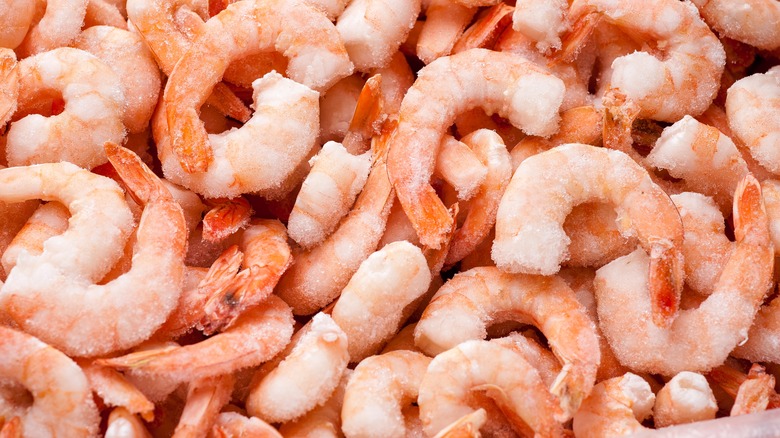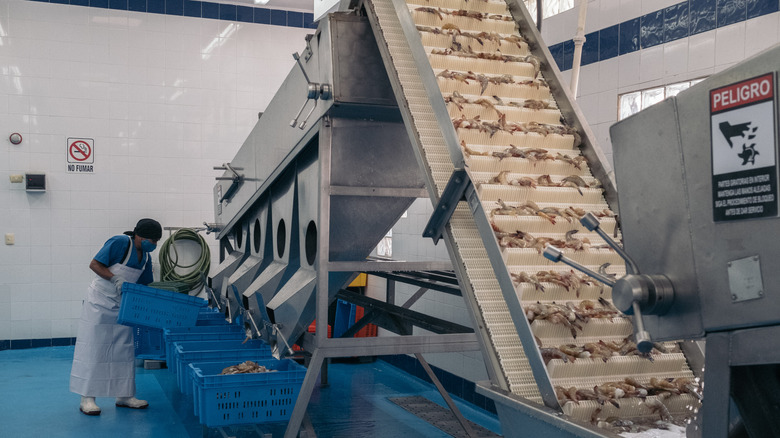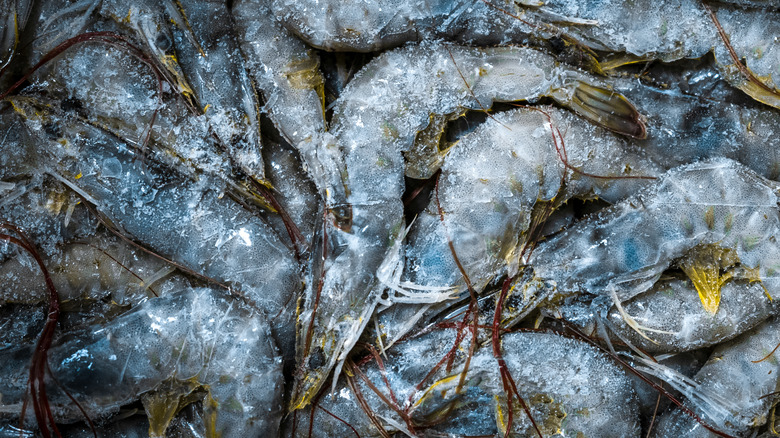What To Look Out For When Buying High-Quality Frozen Shrimp
Americans absolutely love shrimp. Whether it's on an all-you-can-eat buffet, or piled high at a wedding reception, shrimp is by far the favorite kind of seafood in the U.S. where people eat an average of around four pounds each every year, according to NOAA, compared to around two pounds per year of both canned tuna and salmon. Part of the reason why we love shrimp so much is that it's tasty and versatile. What other seafood is as much at home on a chilled seafood tower as it is fried up in a po'boy sandwich? Shrimp is also popular because it's fairly inexpensive, ranging anywhere from $6 to $25 per pound, depending on where you buy it and how it was fished or farmed. That also means that there's a lot of variation in quality, so when you're grocery shopping for shrimp, there are some important indicators to look out for.
If you're shopping for frozen shrimp, which includes almost all shrimp at the grocery store, look for anything on the package that indicates that it was flash-frozen on the boat. Shrimp and other seafood deteriorate rapidly in quality once they're caught, so if the shrimp is frozen right on the boat the freshness is locked in and you know you're getting the best possible product.
Frozen versus fresh
If you're not already buying frozen shrimp at the grocery store, you should start. The fact is, almost all of the shrimp in grocery stores (and all the seafood in general) has been frozen before it gets to the fish counter. This is because they're highly perishable and start to lose quality in just a few hours. So all the raw shrimp that's laid out on the ice in the fish case is almost always actually just thawed frozen shrimp, and because someone did the work to thaw it, it's always more expensive.
Frozen shrimp are not just less expensive than those in the seafood case, in most instances they're also fresher because you don't know how long the fish in the case has been thawed. Unless you live near the coast where shrimp are harvested and have the ability to buy "day boat" fish, which are caught and brought back to land for sale on the same day, or if you can buy live shrimp, frozen shrimp is the way to go. Shrimp boats often go out to sea for an extended period of time, and they are equipped with machinery that allows them to flash freeze the fish on the same day it was caught.
Read the package
Sometimes you can get your shrimp frozen with the heads on in a boat bag, which is a good indication of freshness if you have a good fishmonger. If your shrimp are frozen with the heads on, and you can see through the packaging or if they're loose in a fish case, look for black spots on the head and the body. These spots are from oxidation, which means the shrimp wasn't frozen right away.
Buying shrimp can be a little confusing if you don't know what to look for. Always try to buy your seafood from a grocery store or fishmonger that you trust, and don't be afraid to ask questions if there is someone you can talk to face to face. If you can't talk to someone, however, the shrimp is labeled with a lot of information that you need to know in terms of size and quality. Most of the time the packaging will say that the shrimp is frozen at sea, so check the bag or box carefully for language that tells you what you need to know. If there's no indication of where it was frozen, the shrimp was probably frozen on land, which means they are probably not as fresh.


